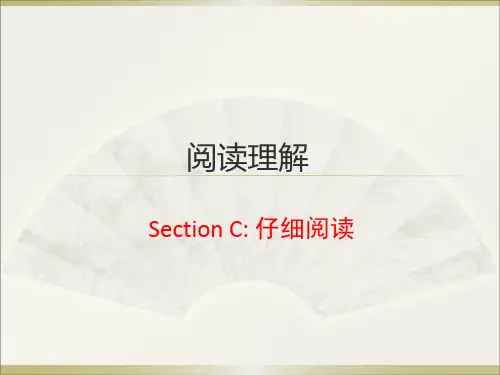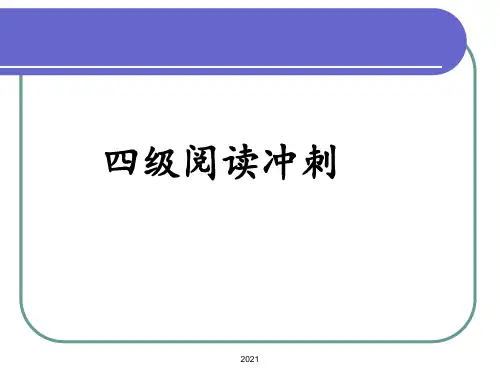大学英语四级长篇阅读技巧课件
- 格式:pdf
- 大小:7.17 MB
- 文档页数:39
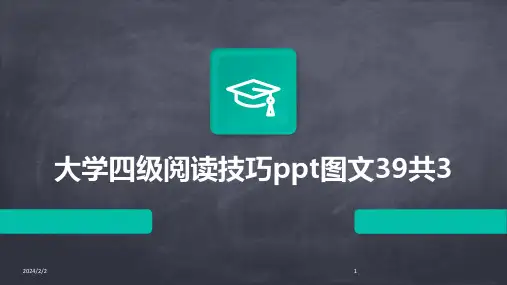
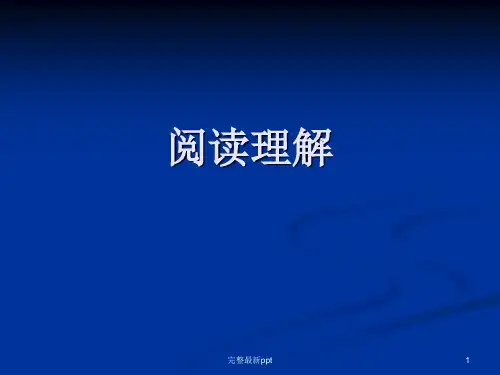
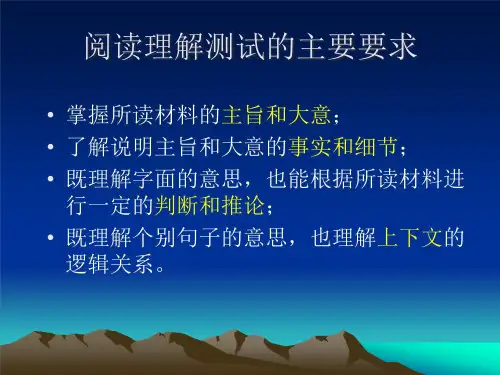

课件•Overview of question types andproblem solving strategies•Tips for solving detail comprehensionproblems目•The method of solving the main ideaproblem录•Strategies for solving reasoning andjudgment problems•How to deal with vocal comprehensionquestions目•Sentence fill in the blank questionanswering skills录01Overview ofquestion typesand problemsolvingstrategiesThese are the most common type of questions in CET-4 reading comprehension, requiring students toselect the best answerfrom multiple options MultipleChoiceQuestionsStudents must determine which statement is true orfalse based on the information provided inthe passage True or False Questions These questions test students' understanding of specific details or concepts by asking them to complete a sentence or paragraph with the correct information Fill in the blank Questions Students must match items from two different lists, such as matching heads with paragraphs or matching definitions with termsMatching Questions Introduction to CET-4 Reading Question TypesGeneral problem solving strategies•Skimming and Scanning: Skimming investments quickly reading the passage to get a general understanding of the main idea, while scanning investments searching for specific information or keywords•Understanding Question Types: Familiarizing yourself with the different types of questions and understanding what each type is asking for can help you approach the passage more effectively •Identifying Key Information: Learning to identify key information in the passage, such as the main idea, supporting details, and the author's purpose or title, is critical for answering questions correctly •Eliminating Incorrect Answers: Narrowing down your options by eliminating answers that are clearly incorrect can help you focus on the most likely correct answersTime management and answering sequence•Allocation Time: It is important to allocate your time willingly when taking the CET-4 reading comprehension section Determine how much time you have for each pass and question, and stick to your plan•Reading the Questions First: Sometimes it can be helpful to read the questions before reading the passage, as this can give you a better idea of what information you should be looking for •Answering Easy Questions First: If you come across a question that seems particularly difficult, it may be best to skip it and come back to it later Answering the eastern questions first can help you build confidence and momentum•Reviewing Your Answers: After you have finished answering all the questions, take a moment to review your answers and make sure that you have not missed any objective misses02Tips forsolving detailcomprehension problemsIdentify key information and vocabularyPay attention to nouns, ve…These word classes often contain important information and help tounderstand the main idea of the textLook for key phrases and presence structuresKey phrases and presence structures can provide clubs to the meaning of thetext and help to locate important information quicklyBe aware of synonyms and antonymsUnderstanding synonyms and antonyms can help to understand the meaningof words in context and avoid misunderstandingsPositioning the original text and answer areaRead the question carefull…Before looking for the answer in the text, it is important to understand whatinformation is being asked forScan the text quickly to locate relevant informationOnce the key information in the question has been identified, scan the textquickly to find the relevant sectionRead the relevant section carefully to find the answerAfter locating the relevant section of the text, read it carefully to find theanswer to the questionTechniques for identifying interference itemsEliminate objectively incorrect optionsSometimes there will be objectively incorrect options that can be identifiedimmediatelyCompare and contrast similar optionsIf there are multiple similar options, compare and contrast them to find the onethat best fits the information in the textUse determination method to arrow down choicesIf there are still several possible answers after identifying objectively incorrectoptions, use the determination method to arrow down the choices furtherExample analysis and practiceAnalyze example questions and answersLooking at example questions and answers can help understand how to apply the tips andtechniques learned in this sectionPractice with real CET-4 questionsPracticing with real CET-4 questions is essential for training confidence and improving problemsolving skillsReview and reflect on performanceAfter practicing, review your answers and reflect on your performance to identify areas forimprovement03The method ofsolving themain ideaproblemRead the title and subtitle to get a general idea of the content Skim through the articlequickly to grasp the mainpoints and structureIdentify the topic presenceof each paragraph tounderstand the main idea ofeach sectionDetermine the central idea of the articlePay attention to keywords that are repeated or emphasized in the textAnalyze the logical relationship between paragraphs to understand the connection betweenideasLook for topic senses at thebeginning or end of eachparagraphIdentify paragraph topic senses and keywordsSummarize the main idea of the article in your own words Identify the author's purposeand attitude towards thetopicAnalyze the languagefeatures and rhetoricaldevices used by the author toconvey the messageSummarize the main idea and techniques of the entire textExample analysis and practiceAnalyze sample questions and answers to understand the question typesand answering techniquesPractice solving main idea problems with different articles and questiontypesReflect on your own answers and compare them with the correct answers toidentify areas for improvement04Strategies forsolvingreasoning andjudgmentproblemsUnderstand the author's viewpoint and titleIdentify key senses and words01Look for topic senses, including senses, and words withemotional color to understand the author's viewpoint and titleAnalyze the author's argument02Examine the evidence and reasoning the author uses to supporttheir viewpoints, and identify any assumptions or biasesAdvisor the author's background03Take into account the author's expertise, experience, and anypotential conflicts of interest that may affect their viewpointInferring implied information or conclusionsRead between the linesLook for hints or clubs in the text that suggests whatthe author may be implying but not directly statingUse logical reasoningApply logical reasoning skills to draw conclusionsbased on the information provided in the textAdvisor the overall contextTake into account the larger context of the text,including the author's purpose and intendedaudience, to infer implied information or conclusionsIdentify facts andopinionsDistinguish between facts and opinions in the text, and determine which are relevant to the question at hand Evaluate evidenceand reasoningAssess the quality andeffectiveness of the evidenceand reasoning provided tosupport a specific viewpointor conclusionProvide reasonsand explanationsClearly explain why a specificanswer is correct or incorrect,and provide evidence andreasoning to support youranswerDetermine right and wrong and provide reasonsAnalyze samplequestionsExamine sample questions and answers to understand the types of reasoning and judgment problems you may account for on the CET-4 exam Identify commonmissesLook for common misses madeby students when solving thesetypes of problems, and learn howto avoid themPractice solvingproblemsPractice solving reasoning andjudgment problems using thestrategies you have learned, andseek feedback on your answers toimprove your skills010203 Example analysis and practice05How to dealwith vocalcomprehension questionsTechniques for guiding the meanings of unfriendly wordsWord formationUnderstanding word roots,prefixes, and suffixes can helpguide the meanings of unknownwordsWord associationAssociating unfriendly words withknown words or concepts can aidin comprehensionUsing examples Looking for examples orillustrations that account forunfamily words can clarify theirmeaningsUsing contextual clues to infer word meaningsReading the presence or pa…Understanding the context can provide includes to the word's meaningPaying attention to grammar and syntaxThe structure of the presence or paragraph can give hints about the meaningof unfriendly wordsConsidering the overall theme or topicUnderstanding the browser theme or topic of the text can help infer themeanings of specific words1 2 3Looking for words or phrases that have similar meanings to the unfriendly word can be aid in comprehensionSearching for synonymsA Thesaurus is a useful tool for finding synonyms and antonyms of unknown words Using a ThesaurusTrying to rephrase the presence containing the unfriendly word can help identify a suitable synonymRephrasing the presenceIdentify synonyms or synonym replacements01 02 03Analyzing sample questionsLooking at sample vocabulary comprehension questions and answers can help understand the types of questions that may be askedPracticing with real CET-4 materialsUsing authentic CET-4 reading materials for practice can help familiarize yourself with the vocabulary and question typesTimed practice sessionsSetting timed practice sessions can help improve speed and accuracy when dealing with vocal comprehension questions during the actual examExample analysis and practice06Sentence fill inthe blankquestionansweringskillsAnalyze sensitivity structure and determine the type of fill in the blankIdentify the subject, predict, andobject of the presence tounderstand its basic structureDetermine the type of fill in theblank, such as noun, verb,advisory, or advisory, based onthe presence structure andcontext Pay attention to any hints or clubs provided by the presence, such as positions, connections, or junction marksChois单击此处添加正文,文字是您思想的提炼,为了最终呈现发布的良好效果,请尽量言简意赅的阐述观点;根据需要可酌情增减文字,以便观者可以准确理解您所传达的信息,请尽量言简意赅的阐述观点;根据需要可酌情增减文字,以便观者可以准确理解您所传达的信息。


